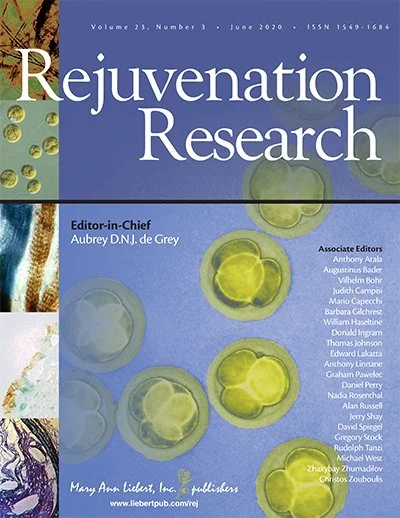LEV Foundation’s work is guided by our founder and Chief Science Officer, Dr. Aubrey de Grey, who since the turn of the millennium has had an unique impact on the birth of the modern field of longevity medicine.
Born in London on April 20th, 1963, the young Aubrey studied at Harrow and later Cambridge, where he read computer science – motivated by the potential of machine learning and robotics to free humankind from the labour of jobs afflicted with the three D’s (dirty, dangerous, and dull).
A chance meeting at a party led de Grey to marriage to the late Dr. Adelaide Carpenter, an American geneticist carrying out research at Cambridge. Adelaide was a passionate cook, and it was thanks to their dinner-time conversations that Aubrey first discovered what he found to be an inexcusable conceit in the field of gerontology, as it existed around the turn of the century: a belief that whilst medicine might soften the symptoms of age-related disease, that aging itself was somehow magical, forever beyond meaningful human influence.
This, he thought, could simply not be true. Coming from an engineering background, it was clear to him that the human body was a kind of machine – one vastly more complex and less well-documented than any man-made device, but at its most fundamental level a machine, failing ultimately not because of some physical law but simply because its capacity for self-repair, whilst remarkable, was not unlimited.
Might we not learn to repair it, though?
The establishment at that time said no: it was impossible, or at the very least so fantastically far off in the future that even to suggest interest in the prospect was toxic to any young academic’s career.
The urgency was obvious; even then, two-thirds of deaths worldwide, and an even greater fraction of the suffering experienced by humankind, were due to age-related ill health. That this might continue longer than necessary, Aubrey found appalling; he resolved to turn his full attention to the problem, diving into the scientific literature and reaching out – both personally and through conferences – to experts in the field.
On June 25th, 2000, at 4’o’clock - in the morning - de Grey, unable to sleep after a day of brainstorming with some of biogerontology’s most influential researchers, arrived at a surprising conclusion. Despite the tangled web of biochemical processes that give rise to the accumulation of age-related damage, and despite the similarly numerous forms of pathology through which it became apparent, that damage itself – in other words, the long-lasting changes to human bodies which underpin the statistical fact that an 80-year-old is over sixty times more likely to die in the coming year than a 20-year-old – seemed to fall into just seven distinct categories.
Better still, for each category, de Grey found there appeared to be a general solution: a strategy that in principle could repair the body, restoring the resilience of youth to patients regardless of their age.
Promising as the concept seemed, it was at that time only one man’s theory - and his peers at the Manhattan Beach workshop for the most part greeted it initially with blank stares, the paradigm shift too large to grasp comfortably. To flesh out the concept Aubrey invited some of them, along with other leading researchers in aging and age-related disease, to a series of four roundtable meetings (2000-2004) to discuss and find potential flaws in the therapeutic platform he dubbed “Strategies for Engineered Negligible Senescence” (“SENS”).
Those roundtables refined parts of the platform, yet revealed no insurmountable scientific barriers to its implementation. There were certainly practical obstacles: not least a desperate lack of funding, rooted in the near-universal belief that the goal was unachievable (and certainly not of commercial interest); as well as a lack of open communication between academics studying the phenomenon of aging and those studying individual age-related disease.
To begin to address the first of those obstacles, de Grey joined forces in 2001 with American entrepreneur Dave Gobel to found a nonprofit, the Methuselah Foundation, with the unabashed goal of supporting ambitious work on the control of aging, and the extension of healthy human lifespans. Methuselah’s mission was clear, but a source for funding on the scale required to tackle the challenge was not.
Inspired by the historic Longitude Rewards - prizes offered by the British in the early 18th century for methods to determine a ship’s position at sea, which although substantial in size were still far less than the total spent by competitors - de Grey and Gobel conceived the “Methuselah Mouse Prize” (later “MPrize”) - an open competition to find the best means to sustain the life of laboratory mice. Remarkably, one of the winning mice (with the memorable name GHR-KO 11C) remains to this day the longest-lived laboratory mouse ever, reaching almost five years of age.
Following the success of the MPrize, Aubrey opened a conversation in 2006 with Peter Diamandis - then well-known as the instigator of the Ansari X Prize - to propose an “X Prize for longevity”: a competition to demonstrate progress in rejuvenation medicine for human patients. The idea was well received, but the challenge of defining a “finish line” was insurmountable - despite one donor giving half a million dollars to investigate credible options, biomarkers of aging were still very poorly understood, and a true longevity-based goal seemed to necessarily require an impractical multi-decadal study.
Never one to give up, Aubrey remained the scientific lead for the nascent X Prize project until he passed the torch to Harvard professor George Church, partly in recognition of Church’s insight that a panel of independent metrics of age reversal could soon become reliable enough to serve as a measure of success independent of survival. He was right - the Healthspan XPrize launched in 2024, with an extraordinary $101 million-dollar prize purse, and more than a hundred teams are now actively competing to win by the deadline of 2030.
To address the second practical obstacle – a missing awareness of the big picture, of how separating research on heart disease and diabetes and Alzheimer’s from the study of aging itself constrains both approaches – Aubrey took on the mammoth task of convening scientific meetings that spanned the full breadth of topics relevant to the medical control of aging. Beginning with the SENS conferences in Cambridge from 2003-2013, these events continued around the world with the Rejuvenation Biotechnology meetings in California, Undoing Aging in Germany, Longevity Summit Dublin in Ireland, and most recently a partnership with the established RAADfest events in the USA.
Unlike most large conferences, Aubrey’s have normally eschewed parallel sessions; all attendees, whatever their background, are encouraged to consider how their work might dovetail with the efforts of others present. To allow those connections to take root, the events also prioritise intensive and genuine networking – an aspect widely applauded by delegates. When those factors are combined with a roster of consistently world-class speakers, it’s no surprise that these meetings have played a key role in reshaping attitudes toward the potential of human life extension across academia – as well as helping to ignite the now-burgeoning longevity industry. It’s notable how many leaders in the field credit Aubrey’s work with bringing their attention to healthy life extension.
With the same goal – of breaking down barriers between existing disciplines – in 2004, de Grey also assumed the helm of the peer-reviewed journal Rejuvenation Research, publishing contributions from any area of science relevant to the control of aging. He served as Editor-in-Chief for almost two decades before stepping back and passing the role to Professor Irina Conboy in 2022. (Aubrey remains “Editor Emeritus”, in recognition of his long stewardship.)
Swaying experts was not enough, though; without public support, Aubrey knew there was little hope of making swift progress. Thankfully, the SENS proposal was provocative enough to attract the attention of the media; he was invited to speak more than once at the iconic TED conferences, featured in print media worldwide, and interviewed by Barbara Walters, Stephen Colbert, Joe Rogan, and many others - even being invited to replace the famed Michio Kaku as a conference keynote.
In 2007, de Grey along with his research aide and coauthor Michael Rae published Ending Aging – a popular science book that explains the SENS platform in relatively non-technical terms, while pulling no punches in laying out the scale of the human suffering and the economic burden imposed by fatalistically accepting the burden of age-related chronic disease. Ending Aging’s focus on fundamental biological mechanisms and the foreseeable strategies that could address their ill-effects means that the core thesis is still as relevant as ever, despite the two decades that have passed since its publication.
In 2009, with Methuselah Foundation demonstrating and supporting commercial interest in rejuvenation therapies through its growing investment fund, de Grey launched his second nonprofit - now focused specifically on driving the basic research necessary to validate and implement the damage-repair therapies he had proposed at the turn of the millennium. Shortly after founding SENS Research Foundation (SRF), Aubrey suffered a deep personal loss – the death of his mother, Cordelia – but, ever determined to make the best of any situation, immediately resolved to allocate the great majority of his sizeable inheritance to fund SRF’s work.
That early gift of more than $10 million, along with the subsequent support of many other donors, enabled the development of a large and multi-focal research program – one which has not only produced dozens of high-quality academic publications, but also enabled the launch of key startups including Cyclarity (now conducting clinical trials of its groundbreaking anti-atherosclerotic therapy), Revel Pharmaceuticals, Oisín Biotechnologies (jointly supported with Methuselah Foundation’s fund) and others.
In 2021, SRF was the beneficiary of the largest cryptocurrency fundraiser in history – the PulseChain Airdrop, orchestrated by blockchain mastermind Richard Heart – raising in excess of $27 million for de Grey’s research. That windfall plus a successful application for NIH funding, and his confidence in the gifted researchers SRF had retained, reassured Aubrey that the foundation had graduated into true mainstream viability.
Dr. de Grey is, by his own admission, a “born heretic”; his leadership is most valuable at the very edge of what is achievable. Thus, in 2022, he launched his third and perhaps most ambitious nonprofit; Longevity Escape Velocity (LEV) Foundation. Building on the success of his first two foundations, LEVF was conceived specifically to identify and address the most challenging obstacles on the path to widespread deployment of functional human rejuvenation therapies.
LEVF pursues both scientific research - centered on our flagship Robust Mouse Rejuvenation program, a large-scale integrative test of how different health-prolonging treatments work in combination - and social outreach, especially through its partners. Particularly, LEVF has provided ongoing foundational support to the Healthspan Action Coalition - a consortium that has grown to over three hundred member organizations, all aligned to the goal of achieving longer, healthier lives. The Coalition is spearheaded by veteran lawyer and trailblazing stem cell research advocate Bernard Siegel, alongside patient advocacy champion Melissa King, co-founder of the California Institute for Regenerative Medicine and a key leader on both of the California state propositions that provided it with billions in initial funding,
Dr. de Grey also donated $400,000 in 2022 to sustain and expand the operations of the popular longevity science media outlet Lifespan.io (Lifespan would subsequently merge with SENS Research Foundation to create the new Lifespan Research Institute), while LEVF provided key initial grants to the Alliance for Longevity Initiatives, driving awareness and commitment to longevity medicine among members of the US Congress, and AfroLongevity, stimulating discussion of rejuvenation research within Africa.









